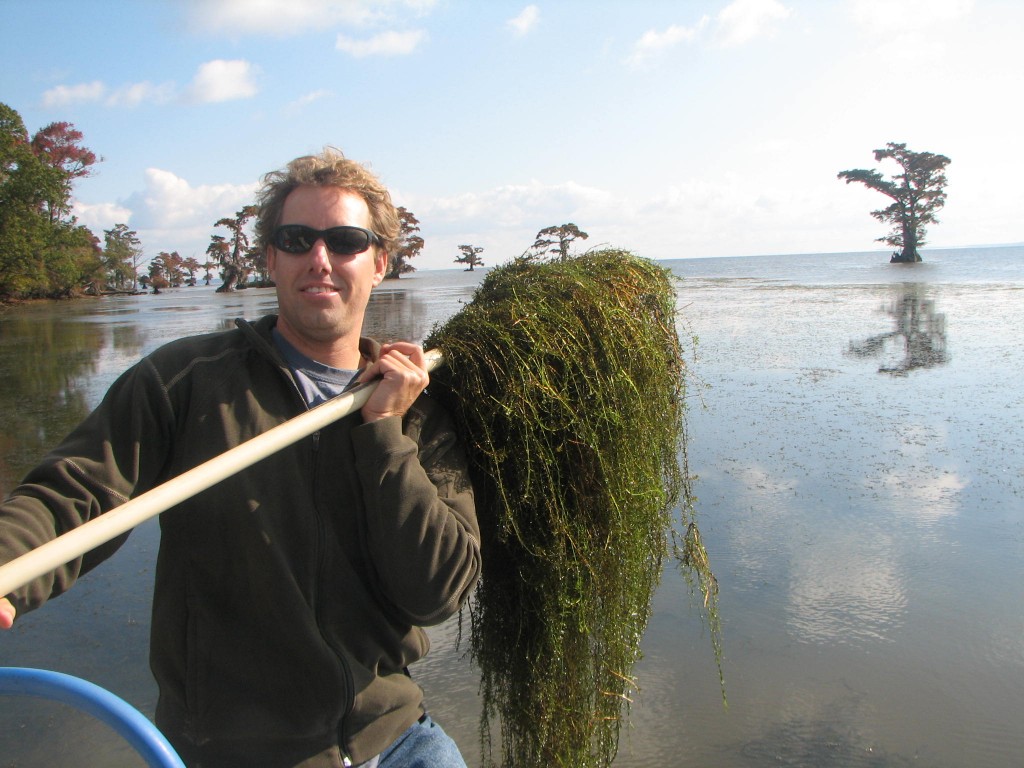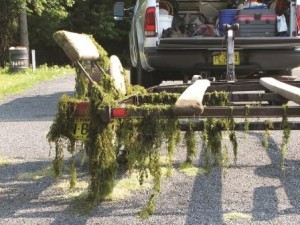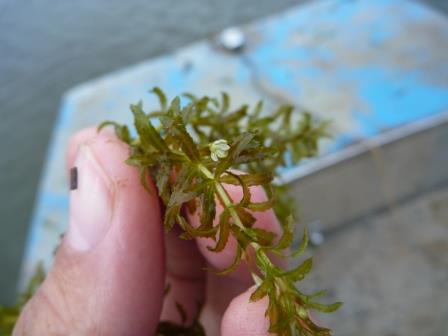Hydrilla: A Concern for the Albemarle Sound Region
Hydrilla verticillata is an aggressively invasive submersed aquatic plant that is not native to North Carolina. It grows fast and forms thick mats at the water’s surface. The plant outcompetes native vegetation, resulting in reduced natural biodiversity.

Communities and agencies are increasingly concerned about Hydrilla in the Albemarle Sound and the surrounding rivers. The plant can negatively impact water-based recreation, recreational and commercial fishing, and local economies. Conditions in these water bodies do not appear to limit the plant’s spread and it is difficult to eradicate. Catching Hydrilla early enough in its spread allows for more efficient control and higher potential to protect coastal rivers and sounds.
North Carolina Sea Grant is coordinating with other agencies and communities to improve our understanding of how Hydrilla is spreading in the Albemarle watershed. With our partners, we raise awareness and educate the public about the issue, and determine how to respond appropriately to maintain healthy coastal ecosystems.
Explore known infestations in the Albemarle Sound watershed.
Hydrilla Resources
- Map of known Hydrilla locations in the Albemarle Sound watershed. To view, click on the map thumbnail, or click on “Open” and select “Open in Map Viewer.” The current map contains limited data but will be updated annually each winter after autumn surveys of Hydrilla are completed, and data are collected and processed. Many additional miles of shoreline are scheduled to be surveyed in 2015.
- Hydrilla plant fact and weed identification sheet from North Carolina State University’s Department of Crop Science.
- General aquatic plant management information and a plant ID smart phone app from NC State’s Aquatic Plant Management website.
- N.C. Department of Environment and Natural Resources Aquatic Weed Control Program.
- Management options for controlling Hydrilla from a program in New York.
- Winter 2011 Coastwatch article: Albemarle Invader: Hydrilla Identified in Sound.
- September 2014 blog post: Hop on Board: The Hydrilla Guerillas are Here.
- Spring 2015 Coastwatch article: Evicting An Invader: Reducing the Spread of Hydrilla?
How You Can Help
Boat owners and marina owners are a key link in stopping the spread of Hydrilla from infested waters to other areas of the Albemarle watershed. Citizen scientists and the general public can also help.
Raise awareness of the issue by sharing resources or this website.
If you think you have found a new infestation of Hydrilla, report it.
Boat Owners

All types of watercraft have the potential to spread Hydrilla, including canoes, kayaks, paddle boats, personal watercraft and sail boats in and out of the water. Boat cleaning helps stop the spread of this and many other invasive species.
Here are some steps boat owners can take:
- Check for, remove and dispose of ALL vegetation in or on your boat and boat trailer after each use. Place any suspicious vegetation in a trash bag and get rid of it at a plant disposal station or trash receptacle, or on the ground in an area well above the high-water mark.
- Look for material trapped between the boat and trailer, inside any open tubing on the trailer, and around taillights and license plates.
- Drain, dry and clean bilges, drop keels, live wells and anything else on the boat that can retain water before moving to another water body.
- Allow boats and trailers to fully air dry (five days or more is preferable) so any hidden plants will completely dry out between boating in different bodies of water OR take boats and trailers to the nearest car wash for a good cleaning.
Marina Owners
Here are some steps marina owners can take:
- Train marina staff to identify Hydrilla and inform boaters of what to do if they find the weed.
- Inform all boaters about the current Hydrilla status.
- Promote the importance of clean boating practices to boaters.
- Check and clean lifts and trailer equipment in the boat yard each time they are used.
- Consider building a plant disposal station. Make sure your boaters know where they are and how to use them correctly. At a minimum, designate an area high above the water line where any vegetation removed during cleaning can be disposed of safely. Students from J.A. Holmes High School in Edenton are helping to install stations at Wildlife Resource Commission boat ramps throughout Chowan County.
Citizen Scientists
Consider becoming a Hydrilla Guerilla. Organize or become part of a trained group of volunteers that complete boat-based surveys for specific watersheds to document Hydrilla infestations.
Training sessions are held in late summer. Surveys take place from late summer to the middle of autumn.
Interested? Contact Gloria Putnam at gloria_putnam@ncsu.edu or 919-513-0117.
General Public
If you think you have found a new infestation of Hydrilla, report it (more below)
Removing Hydrilla by hand is discouraged. Any activity that cuts or breaks apart weeds carries the risk of spreading fragments to other areas, especially with Hydrilla. Additionally, hand harvesting Hydrilla is not effective long-term control because if you do not remove the entire plant, including the tubers buried deep in the soil, it will re-sprout.
If you attempt to remove Hydrilla by hand, minimize fragmentation and capture all pieces. Large fishing nets can be used to help catch some of the fragments, although they are not likely to get all of them.
Report Suspects
Look for Hydrilla in creeks, rivers, bays and elsewhere, especially in the spring through autumn.
If you think you have found a new infestation of Hydrilla, help state agencies track the plant by reporting the sighting through one of the options below.
Online to the N.C. Department of Agriculture and Consumer Services
- Report sightings through the Early Detection and Distribution Mapping System: Southeast Early Detection Network (EDDMapS SEEDN)
Directly to North Carolina Sea Grant
- Record the location with GPS points, if possible. Otherwise, note onshore landmarks.
- Follow guidelines below when taking samples and photos.
- Send the photo and other details, including your name and contact information, to Gloria Putnam at gloria_putnam@ncsu.edu.
Get a Good Specimen and Photos
Follow these tips to get good samples and photos of the Hydrilla you find. The photos you submit with your reports will enable experts to verify your sighting.

- Make sure you can safely and easily get a plant sample.
- Get the entire plant with the roots, if possible. Otherwise, pull off two to three stems with leaves, about 3 to 4 inches long each.
- Preserve your specimen in a plastic bag with a moistened piece of newspaper or paper towel and store in your refrigerator if you are waiting for someone to see it.
- When you are done with it, discard any suspected Hydrilla by drying it out or composting the plant. Keep it away from waterbodies.
Photos
- Take a photo of the plant in the habitat where you found it. Your images should enable the experts to determine the habitat and level of infestation.
- Place the plant on a white background.
- Take at least two photos.
- One shot should be a close-up of the plant that shows the stem and leaves.
- The other should show the entire plant or the whole sample you have.
- If there is a flower, take a photo of it.
- If you dig up the entire plant, take a photo of the root system.
